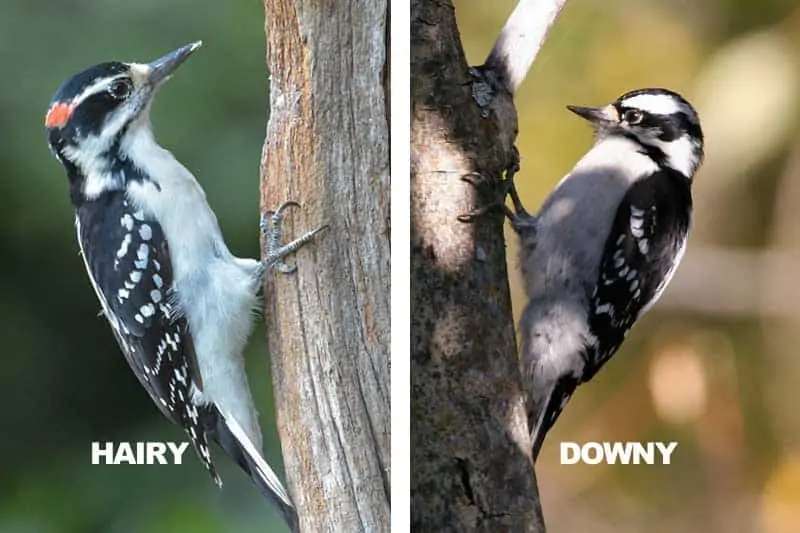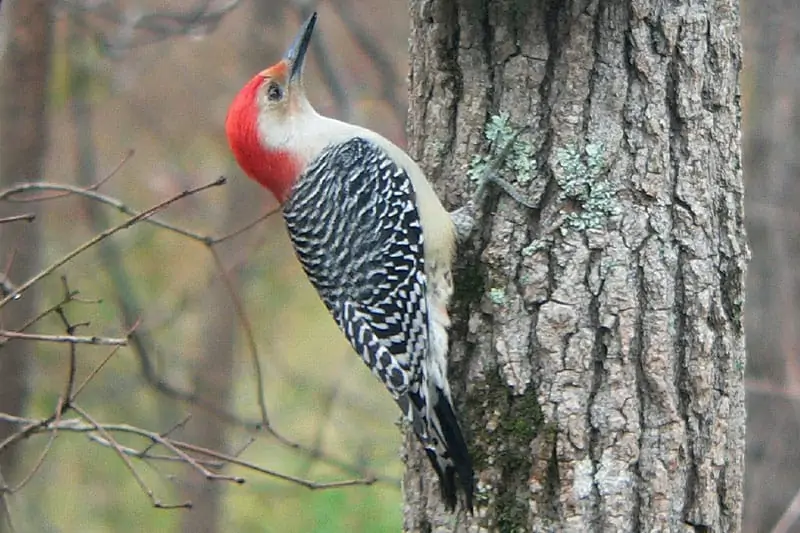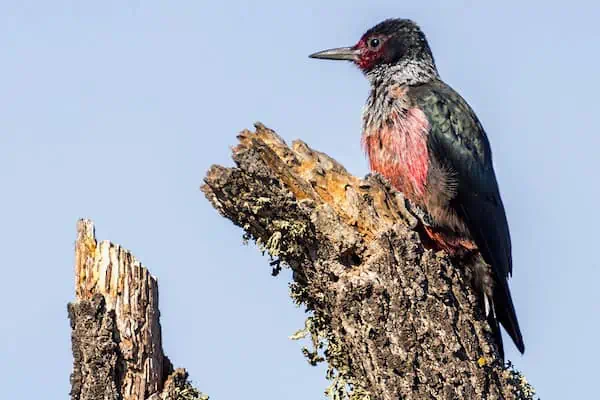It’s really enjoyable to watch woodpeckers. Their ability to drill into trees at high speed while avoiding injury is quite remarkable! We’ll explore nine species of woodpeckers in South Dakota and provide some information about where and when you might see them in this article. We’ll also provide you with some advice on how to attract woodpeckers to your property at the conclusion of the article.
9 SPECIES OF WOODPECKERS IN SOUTH DAKOTA
Although several of these species are widespread in gardens, the Black Hills National Forest is home to at least three that are uncommon. The Black Hills provide a sanctuary for a variety of creatures due to the habitats that exist in the area. Ponderosa pine trees provide plenty of food for the woodpeckers. If you’re interested in seeing new woodpecker species, this is a great place to visit!
Downy woodpecker, hairy woodpecker, northern flicker, red-headed woodpecker, red-bellied woodpecker, yellow-bellied sapsucker, American three-toed woodpecker, black-backed woodpecker and Lewis’ Woodpeckers are the nine species of woodpckers found in South Dakota.
1. DOWNY WOODPECKER

- Scientific name: Dryobates pubescens
- Length: 5.5-6.7 in
- Weight: 0.7-1.0 oz
- Wingspan: 9.8-11.8 in
These tiny woodpeckers may be seen all year in South Dakota, and they can be found almost anywhere. They’re quite widespread across most of the United States. They are the tiniest woodpeckers in North America, and they’re
The white dots on the downy’s backs, as well as its pure white chest and belly, are the only way to tell them apart from a sparrow. A crimson patch appears at the back of the male’s head.
The most common woodpecker species at bird feeders in the backyard is the downy. They appreciate suet, but they also consume sunflower seeds, millet, and peanuts. Your hummingbird feeder is another place where you might see them, since their tiny beak allows them to drink the sugar water.
2. HAIRY WOODPECKER

- Scientific name: Dryobates villosus
- Length: 7.1-10.2 in
- Weight: 1.4-3.4 oz
- Wingspan: 13.0-16.1 in
You might be curious if the bird in this photograph is another downy woodpecker. No, but they do resemble each other. Around the United States, hairy woodpeckers and downy woodpeckers may be found in the same areas. When it comes to identifying which one is which, there will be a lot of confusion.
In comparison to its body size, the hairy woodpecker is substantially bigger and has a longer beak. Here’s a guide on how to distinguish between them that you may find useful.

In terms of habitat, diet, and appearance, these two woodpeckers are almost identical. Throughout the year, they may be found across South Dakota. While they may visit backyard suet feeders, the hairy woodpecker is less prone to approach humans than the downy.
3. NORTHERN FLICKER

- Scientific name: Colaptes auratus
- Length: 11.0-12.2 in
- Weight: 3.9-5.6 oz
- Wingspan: 16.5-20.1 in
In the backyards of the United States, these medium to large-sized woodpeckers are very common. They may be among the most vibrant birds in North America, in my opinion.
Unlike other woodpeckers, flickers prefer to find insects on the ground rather than in trees, and they mainly feed on them. The black splotches on their bellies, solid black bib, barred black and gray wings, and brown face on a gray head are enough to identify them.
Males have a black mustache that females lack. The yellow-shafted variety may be found in South Dakota, and the underside of their wings and tail feathers are bright yellow.
You may be seeing a hybrid of the yellow and red, which sometimes occurs in the western half of South Dakota, if you observe a flicker that doesn’t seem to be like the yellow-shafted variety.
Throughout the year, Northern Flickers can be found in South Dakota, and they may occasionally stop by backyard suet feeders. You may observe them digging for insects among your leaf piles in the yard.
4. RED-HEADED WOODPECKER

- Scientific name: Melanerpes erythrocephalus
- Length: 7.5-9.1 in
- Weight: 2.0-3.2 oz
- Wingspan: 16.5 in
In the spring and summer, red-headed woodpeckers migrate to South Dakota to breed. They’ll return to the eastern United States after that. During the winter, you can expect to experience freezing temperatures.
The crimson/crimson head of the red-headed woodpecker, as well as its black and white color-blocked body, make it easy to spot. They’re less frequent in the backyard than other kinds of woodpeckers, but they do visit suet feeders on occasion. They will eat a variety of nuts and fruits in addition to suet.
Acorns and beech nuts are their favorite foods, which they store in caches for later use. They are one of only four woodpeckers species that does so. These woodpeckers go above and beyond, covering the food with bark or wood to make it more difficult for predators to see.
5. RED-BELLIED WOODPECKER

- Scientific name: Melanerpes carolinus
- Length: 9.4 in
- Weight: 2.0-3.2 oz
- Wingspan: 13.0-16.5 in
South Dakota is not a particularly good place to see the red-bellied woodpecker. The best place to look for them is the southeastern corner of the state, where they can be seen sporadically in the middle.
In their range, these medium-sized woodpeckers may be found at feeders and in backyards. Scent them with suet and bigger nuts to entice them.
You may first notice the bright red stripe down the back of their heads, as well as their heavily barred black and white wings, despite what they are labeled as “red-bellied.” They have a plain white breast, but the lower half of their belly is pinkish-red, which is not always visible.
The tongue of a red-bellied woodpecker may protrude almost 2 inches from the beak. They can lash their tongue out to grab insects from difficult to access areas, with a barbed end and sticky spit.
6. YELLOW-BELLIED SAPSUCKER

- Scientific name: Sphyrapicus varius
- Length: 7.1-8.7 in
- Weight: 1.5-1.9 oz
- Wingspan: 13.4-15.8 in
The sapsucker yellow-bellied breeds throughout the United States’ northeastern region. Winters in the southeast and Mexico, followed by Canada. During the spring and autumn migrations in South Dakota, you may see them traveling back and forth.
They have a yellow wash on their white feathers and a red stripe across the top of their head, which makes them look similar to the downy woodpecker at first glance. A crimson throat will be seen in both males and females.
Because sap is their primary food source, they aren’t often found at bird feeders. Sap is collected with their long tongues, which drill holes into maple, elm, aspen, and birch trees. Their presence is indicated by a row of tiny holes on a tree trunk. They’ll devour a range of insects, some of which get glued in the gluey sap near their wells, in addition to sap.
7. AMERICAN THREE-TOED WOODPECKER

South Dakota is one of the rare places in the United States where you may see the American Three-toed Woodpecker, alongside a few other states in the west. Nonetheless, they are only found in the Black Hills National Forest and are largely missing from the rest of the state.
They favor damaged, ancient growth woods with plenty of dead or burnt trees, which they may readily harvest insect larvae and mine for insects.
Woodpeckers have four toes, known as Zygodactyl toes, in the majority of cases. These woodpeckers, on the other hand, only have three toes. The leverage provided by having just three toes is thought to enable the three-toed woodpecker to lean back farther and strike a stronger blow against its target.
In the United States, woodpeckers are not very frequent. They’re seldom seen at backyard feeders and are mostly found at lakes.
8. BLACK-BACKED WOODPECKER

- Scientific name: Picoides arcticus
- Length: 9.1 in
- Weight: 2.1-3.1 oz
- Wingspan: 15.8-16.5 in
Burned woodlands between the ages of one and eight years old are home to black-backed woodpeckers. In woodlands where wildfires had occurred, the solid black plumage on their backs helped them blend into charred trees. These burnt places are visited by black-backed woodpeckers, who will live in them for years and feast on the larvae of wood-boring beetles and other insects.
These woodpeckers aren’t sure how they find charred woods, but they do so frequently within weeks of a blaze. Like the American three-toed woodpecker, this species only has three toes. They’ll look for bark beetles in unburnt woodlands, as well.
Only in the Black Hills National Forest will you find them where fires have happened in recent years.
9. LEWIS’S WOODPECKER

- Scientific name: Melanerpes lewis
- Length: 10.2-11.0 in
- Weight: 3.1-4.9 oz
- Wingspan: 19.3-20.5 in
During the spring and summer, Lewis’ woodpeckers may be seen in far western South Dakota, particularly in the Black Hills. They prefer pine woods and burnt woods, but their numbers are occasionally erratic. They are known to be found in such places.
Their fall-winter population frequently ends up in different locations year to year after breeding season, since they travel around looking for stores of acorns and nuts. These animals store their provisions in nooks and crannies throughout the winter.
Lewis’s woodpeckers, unlike those of most other species, capture prey in midair. Their flight has a beautiful, crow-like quality due to their broad, rounded wings.
Most woodpeckers have black and white bodies, so their coloring is particularly distinctive. Lewis’ have a pink belly, a red patch over the cheek, and a dark iridescent green on their back and wings. They are quite colorful creatures.
HOW TO ATTRACT WOODPECKERS
Those of us who enjoy watching birds in the garden want to attract as many different kinds as we can. Woodpeckers may be a little more difficult to attract, and they prefer more particular foods than many songbirds. To make your yard more appealing to woodpeckers, follow these suggestions.
- Many species of woodpeckers are brave enough to visit feeders, so offer them food they like. Suet is the finest food for attracting woodpeckers, although various species eat seeds and nuts. If you’re looking for bigger woodpecker species, make sure to get a suet feeder with a tail prop area.
- Woodpeckers like dead and rotting trees with plenty of insect larvae for them to devour. Leave dead trees alone!
- Northern flickers and pileated woodpeckers have been known to use nest boxes, so put up a few
- Woodpeckers may occasionally enjoy fruits and berries like dogwood, serviceberry, tupelo, mountain ash, strawberry, cherry, grapes, bayberry, holly, blueberries, apples, mulberry and brambles.
.
- Woodpeckers will exploit bird baths the same as any other birds, so make sure you have a water source available, such as with a water mover or solar fountain to help attract them.
